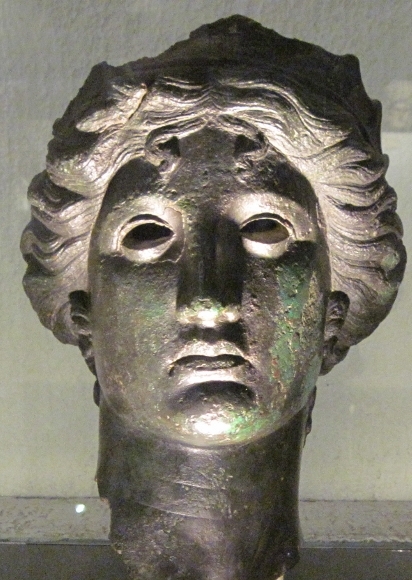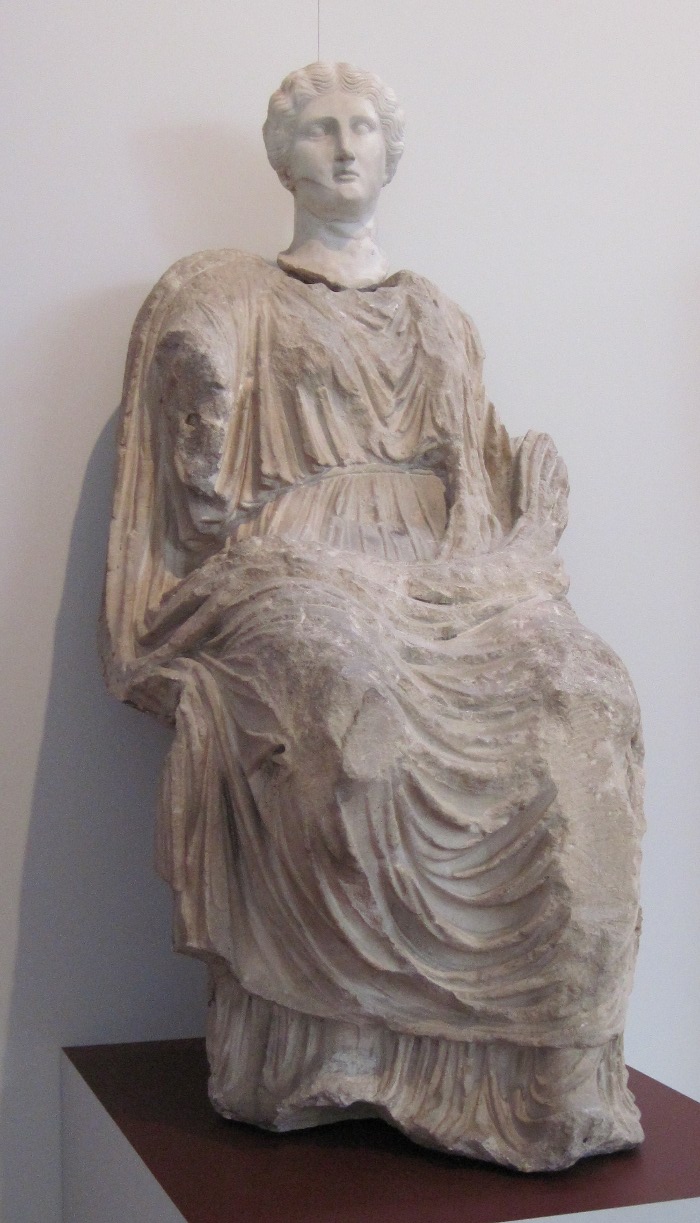
The bronze head of a goddess, dedicated by a citizen of Vienne. It is to be identified as Juno, unless it is an allegorical figure. She wears a diadem. Provenance: Serpaize, département of the Isère.
(Musée de la civilisation gallo-romaine, Lyon)

The character of Juno is as complex as society’s contradictory ideas on women. Juno Regina, queen of the gods, mistress of the heavens, is the chief antagonist in the Æneid no less than in the Iliad. She protects women, particularly pregnant women, and protects the inviolability of marriage. At the same time, she it was who prevented Latona from giving birth to Apollo and Diana on account of the act of adultery by her husband Jupiter that produced her eminent step-children.[1] In short, she incarnates all that the ancients might have thought of Woman, of Wife, of Queen: pride, capriciousness, jealousy, power, seduction and motherhood.
Gaulish dedications to Juno are not rare. Their context is normally with Jupiter Optimus Maximus, underscoring the pair’s complementary role as king and queen of heaven. These two Olympians—brother and sister as well as husband and wife—together look after the good order of the cosmos. The tension that exists between them, a constant motif of their mythology, is what sets in motion the dynamism of the universe, like yin and yang.
With Jupiter’s daughter Minerva, the couple form the Capitoline Triad who oversaw the stability of the Roman state from their holy temple in the Capitol. Quite often, these three together are invoked in the Gallic provinces, most often along the Rhine (i.e. in a heavily militarized zone) to ensure the well-being of the Empire that the soldiery was struggling to protect. In such contexts, invocations of Jupiter and Juno often include long series of other deities, or even “all other immortal gods”.[2]

As woman is widely associated, for good or ill, with domestic life, Juno has a key role in domestic worship. The Kalends—the first day of each month—are dedicated to her,[3] and thus she received the monthly devotions of every Roman household before the little shrine dedicated to the Lares, or household gods. To Juno belongs the empire of the private sphere, as Jupiter presides over public life. One of Juno’s close associates is the Mother of the Lares (Mater Larum), according to the Arval Brethren at Rome. All females are guided not by a ‘genius’, but by a ‘juno’. These powers can be likened to the Suleviæ who stem instead from Celtic roots. One inscription from Rinxent in the Pas-de-Calais even invokes the ‘Suleviæ Junones’, and it is perhaps the Suleviæ that some of the worshippers had in mind who dedicated some fifteen inscriptions in honour of the Junones in Gallia Belgica and Germania Inferior.[2]
The cult of Juno Regina is typically found in such Romanized contexts as the militarized zone along the Rhine, the administrative centre of Trier, the colony of Nîmes, etc. Still, one may wonder whether Juno, to whom the title of Regina ‘queen’ is nearly always accorded, might not perpetuate in a Gallo-Roman context the cult of the Celtic goddess Rigana, who may be attested in a Gaulish-language dedication rigani rosmertiac, ‘to the Queen and to Rosmerta’.[4]
Juno’s attributes are the sceptre, the diadem and at times the patera (offering dish). Her favourite animal is the peacock, followed by the cuckoo and crow. As a symbol of matrimony, the pomegranate can be sacred to her,[1] although this fruit arguably has stronger associations with Pluto and Prosperina.

